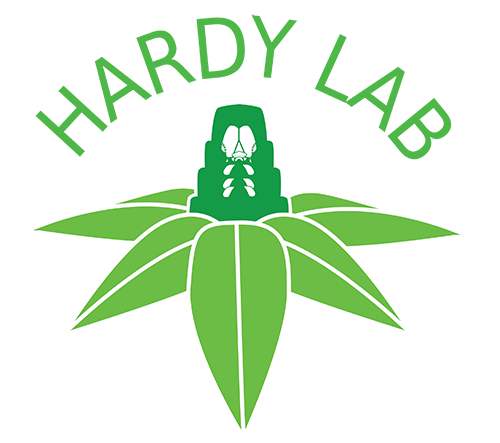Valid Names Results
Platylecanium asymmetricum Morrison, 1921 (Coccidae: Platylecanium)Nomenclatural History
- Platylecanium asymmetricum Morrison 1921: 667. Type data: SINGAPORE: Government Hill, on Pinanga sp.. Syntypes, female, male, and first instar, Type depository: Washington: United States National Entomological Collection, U.S. National Museum of Natural History, District of Columbia, USA; accepted valid name Notes: paratype Morr. / Malaya, (Singapore) / ex coll. U.S. Bur. Ent. / det. H. Morrison / EEG, 16/34. No. 11 (NHML) Paralectotype (Platylecanium / cocotis) / F. Laing det (oval in shape, symmetrical, in good condition) (NHML).
- Platylecanium cocotis Laing 1925a: 59. Type data: VANUATU [=New Hebrides]: Efaate, on coconut.. Lectotype, female, by subsequent designation (WilliaWa1990,143). Type depository: London: The Natural History Museum, England, UK; junior synonym
- Platylecanium assymmetricum Morrison, 1921; Takahashi 1950a: 57. misspelling of species epithet
Common Names
Ecological Associates
Hosts:
Families: 3 | Genera: 4
- Arecaceae
- Cocos nucifera | Laing1925a WilliaWa1990
- Pinanga | Ali1971 Morris1921
- Lauraceae
- Cinnamomum | Takaha1950a
- Zingiberaceae
- Alpinia purpurata | WilliaWa1990
Geographic Distribution
Countries: 6
- Indonesia
- Irian Jaya | Gavril2013
- Malaysia | BenDov1993
- Papua New Guinea | BenDov1993
- Singapore | Ali1971
- Solomon Islands | BenDov1993
- Vanuatu (=New Hebrides) | Laing1925a WilliaBu1987
Keys
- JoshiFi2019: pp.7 ( Adult (F) ) [Species of Platylecanium]
- JoshiFi2019: pp.7 ( Adult (F) ) [Species of Platylecanium] Key as: Platylecanium cocotis
- Tang1991: pp.133 ( Adult (F) ) [China]
- Tang1991: pp.133 ( Adult (F) ) [Asia] Key as: Platylecanium cocotis
Remarks
- Systematics: Platylecanium asymmetricum can be diagnosed by the following combination of character-states: (i) anal plates only slightly longer than their combined width; (ii) each anal plate with a deep cleft on underside of inner margin; (iii) body margin crenulated; (iv) marginal setae significantly longer than dorsal setae; (v) preopercular pores difficult to separate from dorsal simple pores; (vi) preopercular pores relatively few, generally absent from around anterior clear areas; (vii) each stigmatic cleft with 3 long, narrow stigmatic spines; (viii) multilocular disc-pores restricted to abdominal segments VII and VI; (ix) legs each very reduced, mainly to a claw, without digitules, and (x) antennae very reduced, consisting of a basal scape and a further section consisting of remaining segments. Platylecanium asymmetricum is closest to P. mesuae and P. sarawakense in having (i) a crenulate margin; (ii) very reduced antennae; and (iii) multilocular disc-pores with mainly 10 loculi, but recognizable immediately by the unique structure of the anal plates. The only constant morphological difference found between Platylecanium asymmetricum and Platylecanium cocotis was that a strong seta was present on the scape of all specimens of P. asymmetricum whereas not even setal sockets could be detected in this position on specimens of P. cocotis. This small difference is not considered sufficient here to separate the two species, so in Hodgson 2025a, P. cocotis was sunk as a junior synonym of P. asymmetricum Morrison.
- Structure: Unmounted material. Platylecanium asymmetricum was described as follows: “elongate, narrowed at each end, flat, dark reddish brown, sometimes almost blackish in the dried specimens, with more-or-less black mottling, probably due to the drying of the internal organs; eye spots pale, surrounded by a blackish area; all specimens prominently asymmetrical ….” (Morrison 1921). Platylecanium cocotis was originally described as: “dark reddish brown, flat, longish oval, slightly narrower in front than behind, length about one-half greater than breadth, a median longitudinal ridge of white, brittle secretion (which may cover the whole dorsum) present” (Laing 1925). (Hodgson, 2025a)
- General Remarks: Good description and illustration of the adult female given by Tang (1991) and Williams & Watson (1990). The key in the paper, Joshi, S., & Firake, D.M. 2019 First record of Platylecanium nepalense Takagi (Hemiptera: Coccomorpha: Coccidae) from India, with redescription and a key to the species of Platylecanium Cockerell & Robinson, is for species of Platylecanium in the world, but by mistake Joshi wrote it's heading as key to the species known from India. (Joshi, pers. comment)
Illustrations
Citations
- Ali1971: distribution, host, 41
- BenDov1993: catalog, 237
- Gavril2013: distribution, 82
- Hodgso2025a: description, diagnosis, distribution, host, illustration, taxonomy, 155-159
- JoshiFi2019: key, 7
- KondoWa2022a: distribution, host, list, 11
- Laing1925a: description, distribution, host, illustration, taxonomy, 59
- Morris1921: description, distribution, host, illustration, taxonomy, 667-671
- Takaha1950a: distribution, host, 57-58
- Tang1991: description, distribution, host, illustration, taxonomy, 134, 135
- Willia2017a: catalog, list of species, 207, 208
- Willia2017b: list of species, taxonomy, 599
- WilliaBu1987: distribution, host, 93
- WilliaWa1990: description, distribution, host, illustration, taxonomy, 141-143
- ZarkanApTu2021: distribution, host, 160


